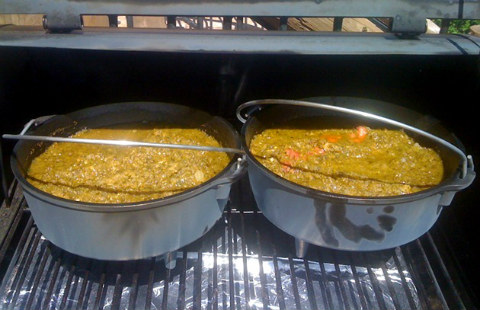Gear
Black Magic: Cast Iron and Live Fire, Part 1

When it comes to cookware for your smoker or grill, cast iron rocks. From its tough black look to its wrist-bending heft. There’s its primal connection to past generations of live-fire hearth masters. And last but not least, its versatility. With a well-seasoned piece of cast iron, you can sear, braise, bake, fry, stew, pan-roast, and even smoke.
Cast iron’s bona fides (and strong connections to food) were established more than 2,500 years ago—the Chinese may have been the first to pour molten iron into molds to make both plowshares and cooking pots.
For grillers, nothing lays on grill marks like a cast iron grill grate. Indeed, the Tuscan grill enables you to grill in your fireplace—especially useful during winter. The cast iron grill press gives you superlative pollo al mattone (chicken under a brick), while the plancha enables you to combine metal plate searing with smoking. Spaniards and Argentineans rely heavily on fire-heated cast iron to cook seafood, vegetables, and of course meats.
Other cast iron pieces appreciated by modern pit masters and camp cooks are skillets, griddles, dutch ovens, pizza pans, and woks.
Today, cast iron is more popular than ever, says Mark Kelly of Lodge Manufacturing, its renaissance propelled by chefs and outdoor cooks: Lodge has been producing cast iron cookware at its factory in South Pittsburg, Tennessee, since 1896. Sales at the company—the only producer of cast iron cookware in America—are up 90 percent in the past decade, Kelly reports. The company has responded by building a new foundry with another one scheduled to go on line within 2 years.
This is great news for cast iron aficionados like Texas-based grillmeister Forres Meadows. An administrator on the Primal Grill with Steven Raichlen Facebook group, he confides he ran amok when he visited Lodge’s outlet store awhile back. He graciously shared a pic of part of his extensive collection.

Photo by Forres Meadows
Meadows, an auctioneer, also has an eye for used or even antique cast iron cookware.
Its durability, of course, is one of cast iron cookware’s many virtues. It’s not unusual to find pieces that are 100 years or older in antique shops or online. Cast iron that is given even a minimum of care is nearly indestructible. Here are tips for maintaining it for a lifetime of use:
- Even cast iron “pre-seasoned” by the factory (all Lodge pieces are sold this way) benefits from this treatment before its first use. Wash the cast iron with warm soapy water to remove any factory grease, then warm in a 350 degree oven for 10 minutes. Remove from the oven and coat with oil—preferably melted vegetable shortening, lard, or other fat (some people swear by coconut oil) using a cloth or paper towels. Place a large sheet of aluminum foil on the lower rack of the oven to collect drips. Return the pot or pan to the upper rack of the oven for 10 minutes. Wipe out any excess oil, then turn it upside down and continue to bake for 1 hour. Turn off the oven, allowing the cast iron to cool in there. Over time and with repeated use, the oils will actually polymerize on the metal’s surface, imbuing it with nonstick properties.
- Clean cast iron promptly after each use. To remove crusty bits after cooking, “deglaze” the still-hot cast iron with a spritz of water. (I like to keep a spray bottle by the grill.) Use a sprinkling of kosher salt and a rag or plastic scrubby to scour the piece if necessary, then rinse. Dry thoroughly in an oven or over a low stove burner, then recoat with fat or oil. Never allow cast iron to soak in water—soapy or any other kind. Also, never store food in or on cast iron.
- A really gnarly piece of cast iron—one that has been severely neglected or abused—can usually be restored with a little bit of effort and patience. First, you’ll need to burn off the old seasoning down to the bare metal by thrusting the pan directly into the embers of a fire until the old coating is reduced to ashes. (Lacking a fire—though I can’t see that happening in this barbecue community—you can also use the self-clean cycle of an oven.) Re-season as described above.
Cast iron’s uses on the grill:
- Sear beef or pork steaks; burgers; chops; chicken breasts, legs, or thighs; salmon or other fish fillets; sea scallops and shrimp; and even tofu on a hot cast iron plancha or skillet.
- Smoke-roast potatoes, yams, Brussels sprouts, broccoli or broccoli rabe, cauliflower, mushrooms, carrots, parsnips, or other root vegetables in a cast iron skillet.
- Use to make smoky fruit crisps or bread pudding. (See my next book, Project Smoke, for a killer recipe for Smoked Chocolate Bread Pudding.)
- Grill breakfast. Cast iron was meant for bacon, corned beef hash, and hashbrown potatoes, not to mention eggs, pancakes, sausages, and one of my favorite morning indulgences, a Mile High Pancake.
- Make an epic pot of stew or chili—here’s the recipe for Barbecue University chili verde with cornbread.

- Use a cast iron skillet or small pot as a receptacle for smoking chips, soaked or unsoaked.
Stay tuned. In Part 2, we’ll share the secrets of dutch oven cooking. What are YOUR favorite ways to cook with cast iron? Let us know on Facebook or the Barbecue Board.
Get some recipes perfect for cast iron:
A New Macaroni and Cheese
Cowboy Rib Eye a la Plancha
PB&J Corn Bread